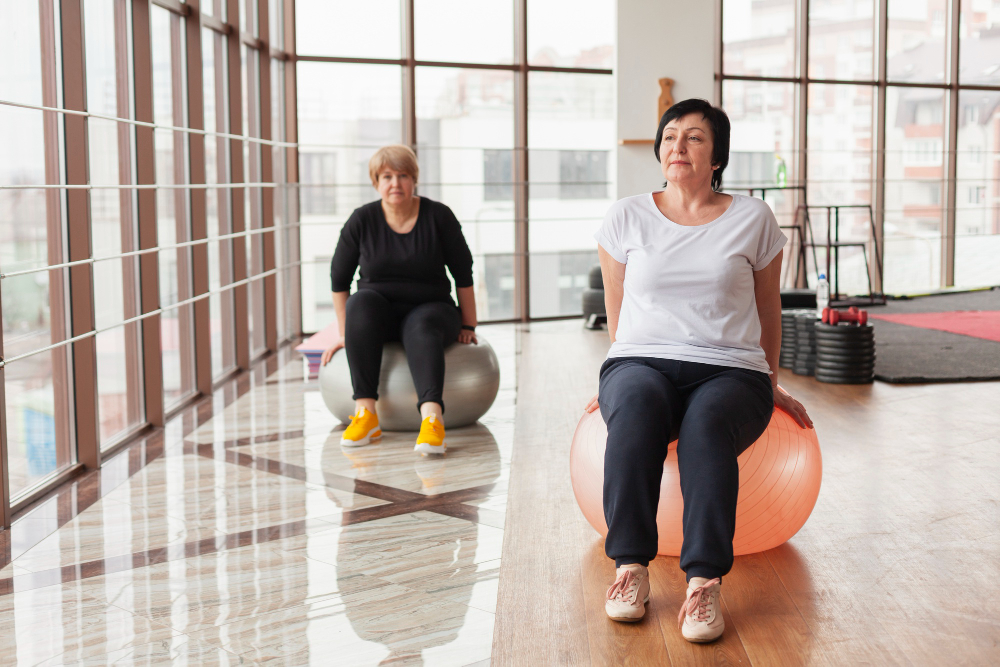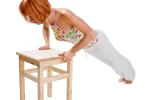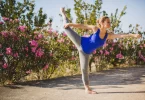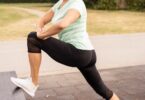Table of Contents
Introduction
What is Seated Yoga?
Seated yoga is a form of yoga practice that focuses on performing poses and stretches while seated on a chair or mat. This type of yoga is especially beneficial for individuals with mobility issues, seniors, or anyone looking for a gentler approach to yoga.
Why Seated Yoga is Beneficial
Seated yoga offers numerous benefits, including improved flexibility, strength, and mental clarity. It is accessible to people of all fitness levels and can be a great way to ease into a regular yoga practice.
Understanding Seated Yoga
History and Origin
Seated yoga has its roots in traditional yoga practices, adapted to meet the needs of those who find it challenging to practice standing or floor poses. It has evolved to become a popular form of exercise in many communities.
Key Principles
The key principles of seated yoga include mindfulness, breath control, and gentle movement. These principles help practitioners achieve a state of relaxation and physical well-being.
Health Benefits of Seated Yoga
Physical Benefits
Seated yoga can improve posture, enhance flexibility, and increase muscle strength. It also helps in alleviating chronic pain and reducing the risk of injury.
Mental Benefits
Practicing seated yoga can lead to reduced stress levels, improved concentration, and a better overall sense of well-being. It encourages mindfulness and a positive outlook on life.
Seated Yoga for Different Age Groups
Seated yoga is an excellent practice that can be adapted for various age groups, providing numerous physical and mental benefits. Here’s a breakdown of seated yoga practices tailored to different age groups:
1. Children (Ages 5-12)
Benefits:
- Improves focus and concentration
- Enhances flexibility and strength
- Promotes relaxation and stress relief
Suggested Poses:
- Seated Forward Bend (Paschimottanasana): Helps stretch the back and legs, promoting flexibility.
- Butterfly Pose (Baddha Konasana): Opens the hips and improves posture.
- Cat-Cow Pose (Marjaryasana-Bitilasana): Encourages spinal flexibility and coordination.
Practice Tips:
- Incorporate fun elements like storytelling or animal sounds to keep children engaged.
- Keep sessions short, around 15-20 minutes, to match their attention span.
2. Teenagers (Ages 13-18)
Benefits:
- Alleviates stress and anxiety
- Boosts self-esteem and body awareness
- Enhances athletic performance
Suggested Poses:
- Seated Twist (Ardha Matsyendrasana): Improves spinal flexibility and digestion.
- Seated Side Bend (Parsva Sukhasana): Stretches the sides of the body, enhancing flexibility.
- Lotus Pose (Padmasana): Promotes calmness and mental clarity.
Practice Tips:
- Encourage mindfulness and deep breathing to manage stress.
- Combine seated yoga with other activities like sports or dance to maintain interest.
3. Adults (Ages 19-59)
Benefits:
- Relieves back pain and tension
- Increases flexibility and strength
- Enhances mental clarity and relaxation
Suggested Poses:
- Seated Forward Fold (Paschimottanasana): Stretches the spine and hamstrings.
- Seated Wide-Legged Forward Bend (Upavistha Konasana): Opens the hips and stretches the inner thighs.
- Cow Face Pose (Gomukhasana): Stretches the shoulders, hips, and chest.
Practice Tips:
- Incorporate breathwork and meditation to reduce stress.
- Practice regularly to maintain flexibility and prevent stiffness.
4. Seniors (Ages 60+)
Benefits:
- Improves mobility and flexibility
- Reduces joint pain and stiffness
- Enhances balance and coordination
Suggested Poses:
- Seated Mountain Pose (Parvatasana): Promotes good posture and breathing.
- Seated Cat-Cow Pose: Maintains spinal flexibility and alleviates back pain.
- Seated Pigeon Pose (Chair Modification): Opens the hips and relieves lower back pain.
Practice Tips:
- Use props like chairs, cushions, or straps for support and comfort.
- Focus on gentle movements and avoid any poses that cause pain or discomfort.
- Encourage deep, slow breathing to enhance relaxation and oxygen intake.
General Tips for Seated Yoga Practice
- Warm-Up: Start with gentle warm-up exercises to prepare the body for deeper stretches.
- Environment: Create a calm, quiet space for practice, free from distractions.
- Breathing: Emphasize the importance of deep, mindful breathing throughout the practice.
- Consistency: Encourage regular practice to see the most benefits, ideally 2-3 times a week.
- Hydration: Stay hydrated before and after the practice.
Seated yoga can be a wonderful addition to the wellness routine for people of all ages, promoting physical health and mental well-being.

Finding Seated Yoga Near Me
Finding seated yoga classes in your area can be a great way to improve your flexibility, strength, and mental well-being. Here are some steps to help you find seated yoga classes near you:
1. Online Search
Use Search Engines:
- Perform a quick search using terms like “seated yoga classes near me,” “chair yoga near me,” or “gentle yoga near me.”
- Include your city or neighborhood in the search for more accurate results.
2. Yoga Studio Websites
Visit Local Yoga Studio Websites:
- Many yoga studios list their class schedules online. Look for classes labeled as “seated yoga,” “chair yoga,” or “gentle yoga.”
- Check the descriptions to ensure they match your needs.
3. Yoga Apps and Platforms
Use Yoga Apps:
- Apps like YogaWorks, Glo, and Down Dog often include class finders or directories of local yoga studios.
- Some apps offer virtual classes if in-person options are limited.
4. Community Centers and Gyms
Check Local Community Centers:
- Many community centers and gyms offer yoga classes, including seated or chair yoga, especially for seniors.
- Visit their websites or call to inquire about their schedules.
5. Social Media and Online Communities
Use Social Media:
- Platforms like Facebook, Instagram, and Meetup can be excellent resources for finding local yoga groups and events.
- Join local wellness or yoga groups to stay updated on upcoming classes and workshops.
6. Ask for Recommendations
Talk to Friends and Family:
- Ask if they know of any seated yoga classes or instructors they can recommend.
- Word of mouth can often lead you to hidden gems in your community.
7. Senior Centers and Health Facilities
Check with Senior Centers:
- If you’re a senior or looking for classes for seniors, local senior centers often provide yoga classes tailored for older adults.
- Health facilities, such as physical therapy centers, may also offer or know of seated yoga classes.
8. Yoga Directories
Use Online Directories:
- Websites like Yoga Alliance and YogaFinder have directories where you can search for registered yoga teachers and studios in your area.
9. Local Advertisements
Look for Flyers and Posters:
- Check bulletin boards in local coffee shops, libraries, and grocery stores. Instructors often post flyers about upcoming classes and events.
Example Search Process:
- Google Search:
- Type “seated yoga classes near me + [Your City]” into Google.
- Review the top results for nearby studios or community centers.
- Visit Studio Websites:
- Visit the websites of the top results and look at their class schedules.
- Social Media Check:
- Search for local yoga groups on Facebook or Instagram.
- Check event listings or posts about seated yoga classes.
- Ask Around:
- Post in local community groups asking for recommendations.
By using these methods, you should be able to find seated yoga classes that suit your needs and preferences. Enjoy your yoga journey!
Online Searches: Use search engines to look for local seated yoga classes. You can start by searching for yoga near me, which provides comprehensive information about finding yoga classes nearby.
Types of Seated Yoga Classes
Seated yoga is a versatile and accessible form of yoga that can be adapted to suit different needs and abilities. Here are some common types of seated yoga classes:
1. Chair Yoga
Overview:
- Uses a chair for support and stability.
- Ideal for seniors, individuals with mobility issues, or those recovering from injury.
Focus:
- Gentle stretches
- Balance exercises
- Breathing techniques
Common Poses:
- Seated Mountain Pose
- Chair Cat-Cow Stretch
- Chair Forward Bend
2. Seated Gentle Yoga
Overview:
- Focuses on gentle movements and stretches.
- Suitable for beginners and those looking for a relaxing practice.
Focus:
- Relaxation
- Flexibility
- Mindfulness
Common Poses:
- Seated Forward Bend
- Seated Twist
- Butterfly Pose
3. Seated Restorative Yoga
Overview:
- Uses props like bolsters, blankets, and blocks to support the body.
- Emphasizes deep relaxation and stress relief.
Focus:
- Deep relaxation
- Stress reduction
- Gentle stretching
Common Poses:
- Supported Seated Forward Fold
- Supported Seated Side Bend
- Reclined Seated Twist (with props)
4. Seated Yoga for Seniors
Overview:
- Tailored specifically for older adults.
- Focuses on maintaining mobility, balance, and strength.
Focus:
- Joint health
- Balance and stability
- Gentle strength building
Common Poses:
- Seated Pigeon Pose (Chair Modification)
- Seated Shoulder Rolls
- Seated Spinal Twist
5. Seated Yoga for Office Workers
Overview:
- Designed to relieve tension and stress from prolonged sitting.
- Suitable for practice during short breaks at work.
Focus:
- Neck and shoulder tension relief
- Spinal flexibility
- Stress reduction
Common Poses:
- Seated Eagle Arms
- Seated Neck Stretches
- Seated Cat-Cow
6. Seated Yoga for Back Pain Relief
Overview:
- Focuses on gentle stretches and movements to alleviate back pain.
- Suitable for individuals with chronic back issues.
Focus:
- Spinal alignment
- Core strengthening
- Gentle stretching
Common Poses:
- Seated Forward Fold
- Seated Spinal Twist
- Seated Cat-Cow
7. Seated Mindfulness and Meditation Yoga
Overview:
- Combines gentle seated yoga poses with mindfulness and meditation practices.
- Focuses on mental clarity and relaxation.
Focus:
- Mindfulness
- Deep breathing
- Meditation
Common Poses:
- Seated Mountain Pose
- Seated Lotus Pose
- Seated Forward Bend (with a focus on breath)
General Tips for Seated Yoga Classes
- Choose the Right Class: Select a class that matches your fitness level, needs, and goals.
- Use Props: Don’t hesitate to use props like chairs, cushions, or straps for additional support and comfort.
- Listen to Your Body: Pay attention to your body’s signals and avoid any movements that cause pain or discomfort.
- Consistent Practice: Regular practice, even for short periods, can lead to significant benefits over time.
- Breathing: Focus on deep, mindful breathing throughout your practice to enhance relaxation and oxygen flow.
Seated yoga classes offer a gentle and effective way to practice yoga, making it accessible to everyone regardless of age, fitness level, or physical ability.
- Beginner Classes: For those new to seated yoga, these classes introduce basic poses and breathing techniques. Chair Yoga for Beginners can be an excellent starting point.
- Intermediate Classes: For those with some experience, these classes offer more challenging poses. Intermediate Chair Yoga can help deepen your practice.
Seated Yoga for Special Conditions
Yoga for Chronic Pain
Seated yoga is an excellent option for individuals dealing with chronic pain. It offers gentle stretches and poses that can help alleviate discomfort.
Yoga for Mobility Issues
For those with mobility issues, seated yoga provides a safe way to stay active and improve flexibility without putting too much strain on the body.
Yoga for Mobility Issues: Offers a safe way to stay active without straining the body. Chair Yoga for Mobility is ideal for those with limited mobility.
Testimonials from Seated Yoga Practitioners
Seated yoga has transformed the lives of many individuals by offering a gentle and accessible approach to yoga. Here are some testimonials from practitioners of seated yoga:
1. Jane, 68
Testimonial: “I started chair yoga a year ago, and it has made a huge difference in my life. I have arthritis, and traditional yoga classes were too challenging for me. Chair yoga allows me to stretch and strengthen my muscles without putting too much strain on my joints. I’ve noticed a significant reduction in my pain levels and an increase in my flexibility. Plus, the relaxation techniques have helped me manage stress better. I highly recommend it to anyone dealing with similar issues.”
2. Tom, 45
Testimonial: “As an office worker, I spend most of my day sitting at a desk, which has led to chronic back pain and stiffness. A colleague recommended seated yoga, and I decided to give it a try. The stretches and poses specifically targeting the back and neck have been incredibly effective. Not only has my back pain decreased, but I also feel more energized and focused at work. It’s a fantastic way to break up the day and take care of my body.”
3. Linda, 53
Testimonial: “Seated yoga has been a game-changer for me. I was diagnosed with multiple sclerosis, and mobility has been a significant challenge. Seated yoga provides a safe and manageable way to keep my body active. The instructors are incredibly understanding and adapt the poses to fit my abilities. I’ve gained strength, improved my balance, and even my mood has lifted. It feels empowering to have a form of exercise that I can do without fear of injury.”
4. Michael, 34
Testimonial: “I initially started chair yoga to support my mom, who has limited mobility. To my surprise, I found it beneficial for myself too. As an athlete recovering from a knee injury, chair yoga offered a way to stay active without aggravating my injury. The emphasis on breathing and mindfulness has also improved my mental game. It’s been a wonderful bonding experience with my mom, and we’ve both seen great improvements in our physical and mental health.”
5. Susan, 72
Testimonial: “After retiring, I wanted to find a gentle exercise routine that would keep me active and healthy. I discovered seated yoga at my local community center, and it has been wonderful. The classes are social, which helps combat the loneliness that can come with retirement. Physically, I feel stronger and more flexible. The breathing exercises have also helped me sleep better at night. Seated yoga has become an essential part of my weekly routine.”
6. David, 50
Testimonial: “Seated yoga has helped me manage my stress and anxiety in ways I never thought possible. I have a high-stress job, and the constant pressure was taking a toll on my health. A friend suggested I try a seated yoga class, and it was a revelation. The combination of gentle movement and mindfulness techniques helps me relax and clear my mind. I leave each class feeling refreshed and better equipped to handle whatever comes my way.”
FAQs
Is Seated Yoga Good for You?
Yes, seated yoga is good for you. It offers numerous benefits, especially for individuals who may find traditional yoga challenging. Some of the key benefits include:
Improved Flexibility: Gentle stretches help to improve flexibility and range of motion.
Increased Strength: Strengthens muscles without putting too much strain on the body.
Better Posture: Promotes good posture and alignment, reducing back and neck pain.
Enhanced Balance: Helps improve balance and coordination, which is particularly beneficial for seniors.
Stress Reduction: Breathing exercises and mindful movements help reduce stress and promote relaxation.
Accessible: Ideal for individuals with mobility issues, seniors, or those recovering from injuries.
Does the Chair Yoga Plan Really Work?
Yes, the chair yoga plan can be very effective. Many practitioners report significant improvements in their physical and mental health. The success of a chair yoga plan depends on the following:
Consistency: Regular practice is key to seeing benefits.
Appropriate Modifications: Ensuring poses are adapted to individual needs and abilities.
Qualified Instructor: A knowledgeable instructor can guide you safely through the exercises and provide modifications as needed.
Is the 28-Day Chair Yoga Plan Free?
The availability and cost of a 28-day chair yoga plan depend on the source offering it. Some online platforms, community centers, or yoga instructors may offer free programs, while others may charge a fee. It’s best to research specific programs or contact providers directly to find out about any costs involved.
Can You Lose Belly Fat with Chair Yoga?
Chair yoga can contribute to overall weight loss and improve body composition, including reducing belly fat when combined with other healthy lifestyle habits. Here’s how chair yoga can help:
Calorie Burn: Although it may not burn as many calories as high-intensity workouts, chair yoga still helps burn calories.
Muscle Toning: Strengthening muscles through chair yoga can boost metabolism, aiding in fat loss.
Stress Reduction: Reducing stress through yoga can lower cortisol levels, which is linked to belly fat.
Mindful Eating: Practicing mindfulness can help improve eating habits, contributing to weight loss.
Conclusion
Recap of Benefits Seated yoga is a versatile and accessible form of exercise that offers numerous physical and mental benefits. It’s suitable for people of all ages and fitness levels.
Encouragement to Try Seated Yoga Whether new to yoga or looking for a gentler practice, seated yoga is worth trying. Find a class near you and start experiencing the benefits today!







